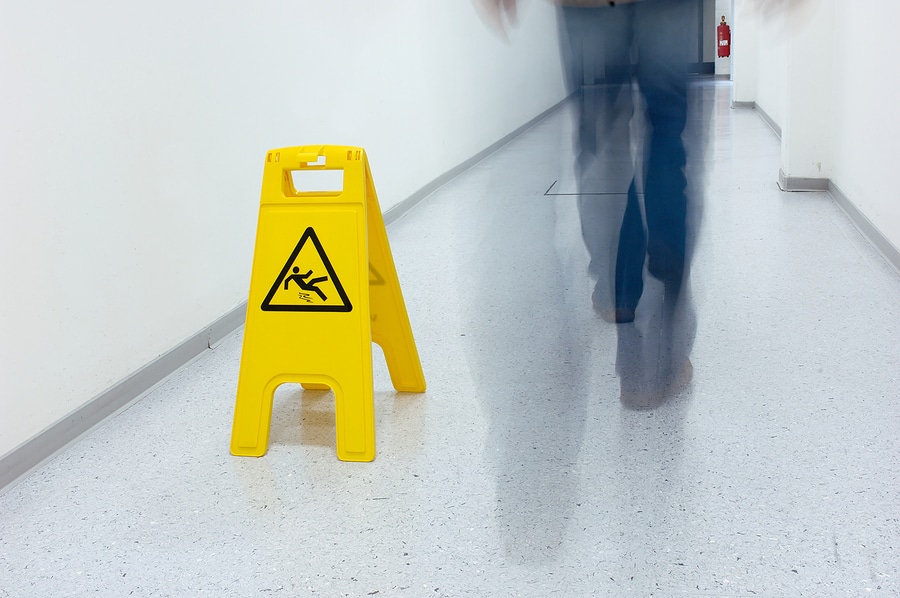What is a Slip and Fall Accident?
Slips and falls are so common that you may have experienced multiple in your lifetime. Slip and fall accidents is a term that is used in personal injury cases to indicate that a person has slipped, fallen, and injured themselves, typically as a result of an object or circumstance that could have otherwise been avoided.
Examples of slip and fall accidents are;
- Slipping on a wet floor that is slippery while shopping at your local store
- Walking down a stairway that is poorly maintained or the handrail fails, and you fall as a result.
- Walking down a hallway that is poorly lit and tripping on an uneven floor
- Slipping or tripping on an item on the floor of a store that should not be there and is hazardous
What Are Common Injuries From Slip and Fall Accidents?
Injuries can vary significantly based on the circumstances, but slip and fall accidents frequently lead to broken bones, fractures, or joint injuries such as wrists or knees.

Another common injury from a slip and fall accident can be a head injury. These can be especially concerning due to the risk of traumatic brain injury or brain hemorrhages leading to permanent damage or even death.
Negligence in Slip and Fall Accidents
Negligence is a factor when pursuing slip and fall personal injury cases. The property owner or the person tasked with maintaining the property where you experienced the slip and fall may be liable for the damages you incurred.
To prove negligence, there must be a duty of care by the property owner, such as a reasonable duty to properly maintain their property or grounds. There must be a proven breach of their duty that directly led to your slip and fall, and as a result of this breach, you suffered injuries. If these pieces can be successfully proven, you likely have a personal injury case to pursue.
What if I Was Shopping While I Was Injured?
If you were in a store and slipped on a wet or slippery floor and injured yourself, in many cases, the store owner or management would be liable for your injuries. If they were aware of the slippery surface and did nothing to remedy the situation, they would have disregarded their reasonable duty of care to you as the shopper in the store.

Store owners have a critical responsibility to their guests as they invite them to shop and benefit from customers being in the store. They must take precautions to avoid hazards and anticipate risks to a certain degree to prevent liability in slip and fall cases.
What if I am at a Friend’s House While I Was Injured?
If you are on personal property, such as a friend’s or family member’s house, and you slipped and fell, injuring yourself, they may be partially liable for your injuries. Though they don’t have as significant a duty of care that a store owner may have to ensure your safety, they will still have a reasonable duty to you.
For example, perhaps you were walking downstairs at your uncle’s house, and the stairs gave way, causing you to fall and injure yourself. In this case, the uncle, as the homeowner, may be partially liable for your injuries if they were aware of the faulty steps and didn’t warn you or fix them. Their reasonable duty of care, if they knew of the faulty steps, would be to warn you, help you avoid them, or fix them before allowing others in that area of the home.
Modified Comparative Negligence
As previously mentioned, negligence is a crucial factor in personal injury cases. What if multiple parties were liable for the injuries? You may have played a role in the injury occurring by acting recklessly, and it may also be established that the property owner was partially at fault.
When this occurs, each party is assigned a percentage of the fault that led to the injuries. If you are found to be 51% or more at fault for the accident, you are typically unable to recover damages. So what if you are found to be 10% at fault, and the property owner is found to be 90% at fault? In this case, if the total damages awarded for the personal injury were $10,000, your portion would be reduced by 10% as you were found to be partially at fault for the accident occurring.

For example, suppose there was a warning sign in a store letting you know of that area being wet or slippery, and you chose to enter the area and ignore the safety warning. You may be found to be partially at fault for any injuries sustained, therefore reducing or eliminating the amount of damages that you would be eligible for in a personal injury case.
A Tireless Advocate When You Need it the Most
Slips and fall injuries can vary from significant to catastrophic in nature. The main priority is seeking medical assistance and ensuring that you address any damages you may have sustained. If you or a loved one are facing mounting medical bills and the other parties are unwilling to work with you, it may be time to pursue a personal injury case.
Contact our office at (803) 855-1012 to determine your options and formulate a strategy with us to pursue what you deserve. We have helped thousands of families ensure that they can obtain the compensation they so rightfully deserve. Don’t let an incident change your life forever. Rely on an experienced, compassionate, and competent team to be your advocate when you need it the most.





